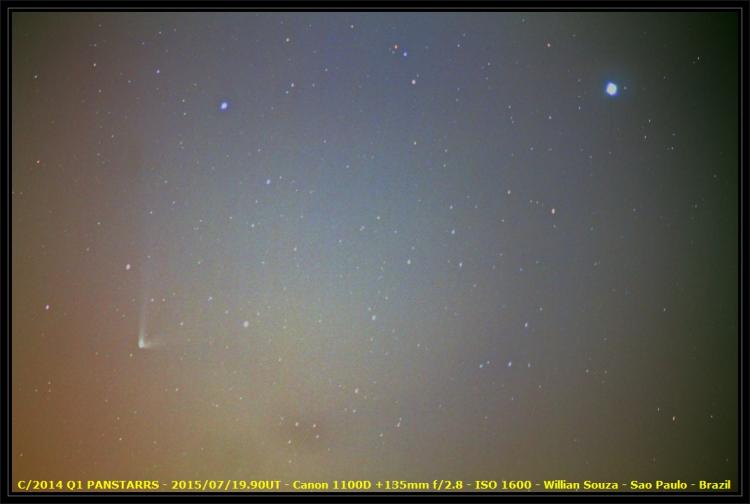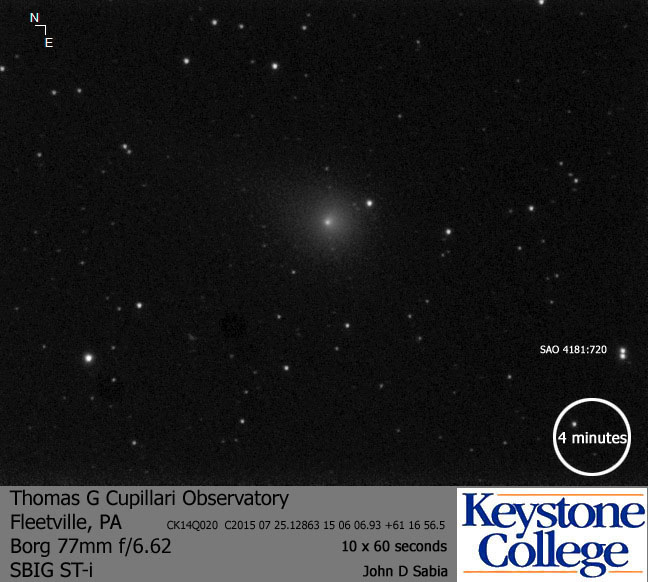ALPO COMET SECTION NEWS FOR AUGUST 2015
2015-August-02
The southern hemisphere holds a monopoly on bright comets this August. Both C/2013 US10 (Catalina) and C/2014 Q1 (PANSTARRS) will be invisible for northern mid-latitude observers while well placed for those down south. Last month, Comet C/2014 Q1 (PANSTARRS) vied for the title of brightest comet of 2015 as it brightened to around 4th magnitude.
Evening Comets
C/2014 Q1 (PANSTARRS) [Perihelion on 2015-Jul-06 at 0.31 AU from the Sun]
After peaking around magnitude 4.0 near its early July perihelion, the comet has rapidly faded as expected. ALPO contributor Willian Souza of Brazil has been following C/2014 Q1 over the past few weeks and reported it fading from magnitude 5.2 on the 17th to 6.5 on the 27th. August will see it continue to fade from around magnitude 7.0 to 9.5 as it moves away from both the Sun (0.77 to 1.38 AU) and Earth (1.25 to 1.76 AU). The comet spends the month moving through the following constellations: Sextans (Aug 1-3), Hydra (3-4), Crater (4-17), Hydra (17-29) and Centaurus (29-31).
The comet is currently rather photogenic. In addition to the Willian Souza image shown below, see the spectacular image on Spaceweather.com taken by master comet imager Michael Jager (observing from Namibia).
Recent ALPO images and observations of C/2014 Q1 (PANSTARRS) can be found in the Comet Section Image Gallery and Magnitude Database. Finder charts can be found at the ALPO Comet Finder Chart page.
C/2014 Q2 (Lovejoy) [Perihelion on 2015-Jan-30 at 1.29 AU from the Sun]
Comet Lovejoy is still with us at it slowly fades. The brightest northern comet, Lovejoy is still around 10th magnitude though over 6 months past its January perihelion. It is located in the far northern sky as it slowly moves south through Draco (Aug 1-6), Boötes (6-7), Draco (7-11), Boötes (11-31). Its distance from the Sun (2.82 to 3.15 AU) and Earth (2.84 to 3.27 AU) continues to increase resulting in continued slow fading. Below image taken by ALPO member John Sabia on July 25.
Recent ALPO images and observations of C/2014 Q2 (Lovejoy) can be found in the Comet Section Image Gallery and Magnitude Database. Finder charts can be found at the ALPO Comet Finder Chart page.
C/2013 US10 (Catalina) [Perihelion on 2015-Nov-15 at 0.82 AU from the Sun]
The second brightest comet in the sky is still inbound towards a mid-November perihelion at 0.82 AU from the Sun. C/2013 US10 (Catalina) will only be visible to southern observers this month as it moves through Tucana (Aug 1-3), Indus (3-7), Pavo (7-17), Apus (17-21), Triangulum Australe (21-31) and Norma (31). Willian Souza has also been following this comet and reported it at magnitude 8.2 on the 27th.
Catalina sees its heliocentric distance decrease from 1.97 to 1.56 AU. Its geocentric distance starts at 1.16 AU, reaches a minimum of 1.09 AU at mid-month and increase to 1.21 AU by month’s end. It should brighten from its current brightness of magnitude 8.0 to 8.5 to around magnitude 7.0 to 7.5 by September 1. If the comet continues to brighten at its current rate it may reach 5th to 6th magnitude in November to January. By late November, it will once again be visible to northern comet watchers.
Recent ALPO images and observations of C/2013 US10 (Catalina) can be found in the Comet Section Image Gallery and Magnitude Database. Finder charts can be found at the ALPO Comet Finder Chart page.
New Discoveries
P/2015 M2 (PANSTARRS) is technically a Centaur comet as its perihelion distance of 5.93 AU is outside of Jupiter’s orbit while its aphelion distance of 8.48 AU is well within the orbit of Neptune and is actually much closer to Saturn. It’s orbital period is ~19 years. P/2015 M2 was discovered on June 28 at 19th magnitude and should not get much brighter.
C/2015 M3 (PANSTARRS) is on a ~1500 year orbit with a late August 2015 perihelion distance of 3.55 AU. Found on June 29 at 19th magnitude, M3 is another comet that will not get much brighter.
C/2015 O1 (PANSTARRS) could be a nice comet in late 2016-early 2017. Could. be. The original orbit has it reaching perihelion in early February 2017 at 1.04 AU from the Sun and ~1 AU from Earth. The problem is the orbit is highly uncertain and there is a possibility the comet’s perihelion will be at a much larger distance so we’ll have to wait for a revised orbit. C/2015 O1 was found at 18th magnitude on July 19.
As always, the Comet Section is happy to receive all comet observations, whether images, drawings or magnitude estimates.
- Carl Hergenrother (ALPO Comet Section Coordinator)





